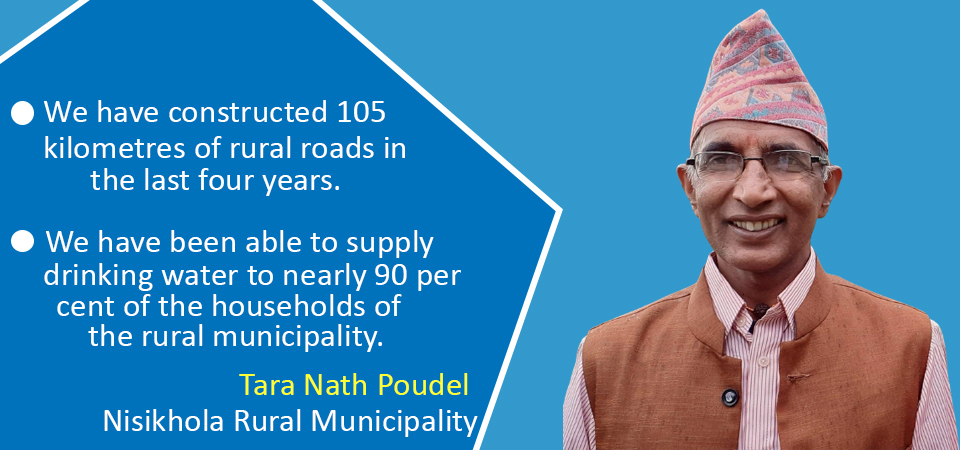We have provided water supply to 90% households

Nisikhola Rural Municipality is one of the 10 local levels of Baglung district formed by merging four former village development committees Devisthan, Bohoragaun, Nisi and Rajkut. Until a few years ago, Nisikhola was one of the remotest parts of the district. But now, with 42 kilometres of the Pushpalal Mid-Hill Highway passing through the rural municipality, it is gradually transforming itself into a developed and accessible local unit. The Rising Nepal’s Gandaki correspondent Chandra Prakash Sharma interviewed Tara Nath Poudel, who was elected chairman of the rural municipality four years ago from the Nepali Congress party. Excerpts:
What works have you done since your election?
We have constructed 105 kilometres of rural roads in the last four years. Similarly, we have been able to supply drinking water to nearly 90 per cent of the households of the rural municipality. Small and large irrigation projects, tourism infrastructure, an administrative building for the rural municipality and buildings for three ward offices have already been built.
How did the rural municipality provide drinking water to 90 per cent of the households?
We were able to manage it by first managing the sources of drinking water and then developing a system to supply that water to the houses. For this, the rural municipality implemented a project in coordination with the provincial and federal governments as well as organisations like Water for Health Nepal (WFH-N) and Gorkha Welfare Trust.
All the houses here have electricity. How did you manage that?
Due to its geographical remoteness, Nisikhola does not yet have access to the central transmission line. Nevertheless, small local hydropower projects have been providing electricity to the houses here. We have 13 local hydropower projects whose capacities range from eight kilowatts to 100 kilowatts.
For places far away from the hydropower projects, we plan to use solar lights to illuminate the houses. However, this plan has not been implemented yet. The government of Gandaki Province stated that it would provide the budget for this under its “Bright Province” programme, but we have not received anything yet.
One problem we have been facing is that it costs more to repair the hydroelectricity projects constructed by the local people through voluntary donations.
Which sectors are the key to the rural municipality’s prosperity?
For the prosperity of the rural municipality, we have focused on infrastructure construction as well as the socio-economic development of the people.
The construction of Pushpalal Mid-Hill Highway has connected Nisikhola with the national road network. Similarly, the Saljhandi-Dho and Patan roads will also have a positive impact on the lives of the residents of the rural municipality. As roads will facilitate the transport and sale of products, we plan to encourage villagers to take up commercial agriculture.
Likewise, we have drafted a master plan for the development of important tourist areas like Narsinghkot and Patihalne. We are also constructing foot trails in the Arnakot and Nangedheri areas.
Nisikhola is a flood and landslide-prone area. What works have you done in the field of disaster mitigation?
More than 250 houses here have been irreparably damaged by landslides. Since the federal and provincial governments have promised to build houses for the disaster-affected people, the rural municipality has not spent its limited resources for this. We focus more on providing necessary relief like clothing and temporary shelter during the times of disaster. We have also launched a campaign to replace the thatched roofs of the houses of the economically disadvantaged people with corrugated sheets. Under this campaign, we have made 120 houses thatch-roof-free to date.
What is the rural municipality doing to improve the quality of education and health?
We are working tirelessly to improve the quality of education in the rural municipality. But a huge problem is that we do not have adequate number of teachers. The number of teaching posts is grossly inadequate for the number of students we have in our schools. The government has set up schools but has not created teachers’ post. Because of this, the rural municipality has had to spend Rs. 15 million to pay the teachers. We were told that 92 posts would be created for the schools of the rural municipality, but nothing has been done yet.
The state has not invested sufficiently in the education sector. As a result, the locals have to collect donations for the schools and the local level has to spend additional money on teachers' salaries.
In the health sector, we have established health posts in all seven wards of the rural municipality and have been providing basic health services to the people. We have also started constructing a hospital. We would like to acknowledge that the rural municipality has received assistance from various non-governmental organisations for the management of manpower and the construction of physical infrastructure. We have provided additional incentives to female health volunteers like mobile phones.
Recent News

Do not make expressions casting dout on election: EC
14 Apr, 2022
CM Bhatta says may New Year 2079 BS inspire positive thinking
14 Apr, 2022
Three new cases, 44 recoveries in 24 hours
14 Apr, 2022
689 climbers of 84 teams so far acquire permits for climbing various peaks this spring season
14 Apr, 2022
How the rising cost of living crisis is impacting Nepal
14 Apr, 2022
US military confirms an interstellar meteor collided with Earth
14 Apr, 2022
Valneva Covid vaccine approved for use in UK
14 Apr, 2022
Chair Prachanda highlights need of unity among Maoist, Communist forces
14 Apr, 2022
Ranbir Kapoor and Alia Bhatt: Bollywood toasts star couple on wedding
14 Apr, 2022
President Bhandari confers decorations (Photo Feature)
14 Apr, 2022










